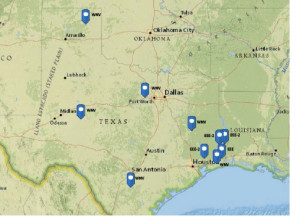7 Cases of West Nile Virus, 7 Cases of EEE Confirmed in Texas Horses
Information courtesy of Texas A&M Veterinary Medical Diagnostic Laboratory
Since July 3, 2015, the Texas A&M Veterinary Medical Diagnostic Laboratory (TVMDL) has reported multiple positive cases of West Nile virus (WNV) and Eastern Equine Encephalitis (EEE) in horses located across the state of Texas. Heavy rains this spring created a breeding ground for mosquitoes, the transmission vector for both WNV and EEE. From the southeastern Gulf Coast to the Panhandle, horses are more susceptible to these two potentially fatal neurological diseases in all parts of the state.
WNV is a viral disease that normally cycles between wild birds and mosquitoes. As the virus infection rate increases in birds it is more likely to be spread to mosquitos that in turn bite horses and humans. The virus abruptly attacks the central nervous system. No horse, regardless of age, is immune to WNV infection. In the U.S., clinical signs for WNV develop in only 10-39 percent of infected horses. The death rate among U.S. horses ranges from 30 to 40 percent for West Nile disease. Of horses that recover from the disease, up to 40 percent may exhibit neurological signs for six months or more after the initial diagnosis. Symptoms for other neurologic diseases can present similarly; diagnostic testing is the only method to definitively determine infection. Clinical signs usually include depression, ataxia, lameness, partial paralysis, muscle twitching or recumbency. Horses may also exhibit an altered mental state, a reduced appetite, grinding of teeth, blindness or a fever.
As of August 11, 2015, TVMDL can confirm 7 horses have tested positive for WNV. They are located in the following counties:
1. Houston County
2. Atascosa County
3. Jefferson County
4. Roberts County
5. Sterling County
6. Parker County
7. Randall County
The common thread in all positive cases is that the affected horses were not previously vaccinated against the disease. The WNV cases are spread from south Texas to the Dallas area and into the Panhandle.
“We often think of these mosquito-borne diseases to be restricted to coastal areas where annual rainfall levels are so much higher,” said R. Gayman Helman, DVM, PhD, MA, resident director of TVMDL Amarillo. “But, in reality, they can and do occur far beyond the coastal areas. This is especially true this year with elevated rainfall levels we have received across Texas. There are highly effective vaccines for both WNV and EEE. These, in addition to effective and consistent mosquito control, provide the best protection for horses.”
EEE is a viral disease that also normally cycles between wild birds and mosquitoes. As the virus infection rate increases in birds it is more likely to be transmitted by an infected mosquito that bites horses and humans. The virus abruptly attacks the central nervous system. As with WNV, EEE cannot be transmitted from horse to horse, or from a horse to a human. Horses and humans are considered “dead-end” hosts, meaning if infected they cannot transmit the virus back to feeding mosquitoes.
Of the neurologic diseases that affect horses, EEE has the highest mortality rate. Practitioners reported that most of the infected horses displayed classic signs of EEE: flaccid (droopy) lips, dullness, muscle fasciculation, ataxia and head pressing.
As of August 11, 2015, TVMDL can confirm 7 horses have tested positive for EEE. They are located in the following counties:
1. Orange County
2. Newton County (2 cases)
3. Liberty County (2 cases)
4. Jasper County (2 cases)
Similar to the cases of WNV, the horses were not known to have vaccination history for EEE.
Symptoms for equine neurologic diseases can present similarly. Diagnosing a neurologic case with only clinical symptoms is difficult; TVMDL recommends diagnostic testing as a confirmatory method to definitively determine infection. In order to have a complete diagnostic picture, TVMDL also recommends veterinarians request additional tests including: Equine Herpesvirus-1, Western Equine Encephalitis and Venezuelan Equine Encephalitis.
As a zoonotic disease of interest, when a WNV case is confirmed positive TVMDL notifies the Texas Animal Health Commission (TAHC). Human infection with WNV is known to occur in the U.S. However, horse to human transmission is not a concern. EEE is a reportable zoonotic disease; the Texas Department of State Health Services (DSHS) and the TAHC were made aware of the positive test results. Human infection with EEE is relatively infrequent in the United States.
TVMDL, TAHC and the DSHS have information related to West Nile virus and mosquito control available for free download. For more information on TVMDL’s equine neurologic testing, visit tvmdl.tamu.edu, or contact the agency headquarters at 1.888.646.5623.











